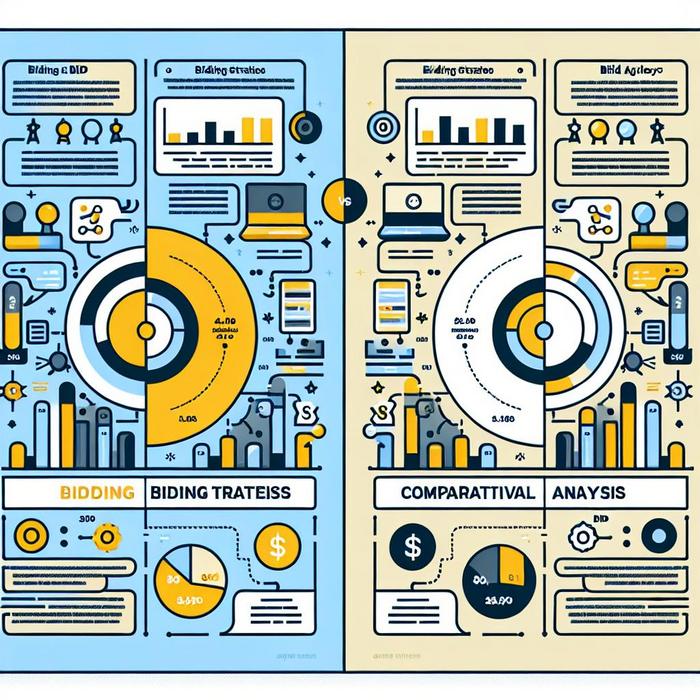TikTok Bidding Strategies VS Google Bidding Tactics: A Playbook for High-Level Executives
TikTok Bidding: A New Frontier of Opportunity
Navigating the digital marketing landscape, one can’t help but be attracted to the burgeoning platform of TikTok. With an extensive reach and dynamism, TikTok has proved its mettle as a viable advertising channel. TikTok’s bidding strategies, an innovative approach to digital advertising, have captured the attention of decision-making executives across all industries.
As an experienced digital marketer, I remember the first campaign I launched on TikTok. Unlike Google or Meta, this platform was unique. It was less about keywords and more about the creative aspect. It lead me to envision a different strategy when it came to reaching my audience. TikTok’s bidding strategies allowed me to push real-time Life-Time-Value (LTV) and adjust impression bids for prospects in the most cost-effective way.
I started to realize the game-changing potential of this strategy when the engagement rates surged dramatically. The click-through rate outperformed those from our previous Google and Meta ad campaigns. To better understand TikTok’s bidding strategies, this resource proved to be incredibly useful.
Google Bidding: Tried and Tested
In contrast, Google bids have always been an integral part of every marketer’s toolkit. Google offers a myriad of bidding strategies, each with a different objective and pricing model. Through my many years in the digital marketing realm, Google has always been a reliable platform for PPC campaigns. It allowed for data-driven decision-making, yielding solid results across various industries.
Google’s strategy is rooted in keywords and analytics. Coupled with the real-time LTV, Google’s algorithms efficiently set impression bids for those prospects most likely to yield value. Google’s strength lies in its inherent ability to adapt its strategy depending on the business’s advertising goals, whether it’s leads, website traffic, product and brand consideration, or sales.
However, I did notice one major difference between Google and TikTok – the audience engagement. While Google yielded higher conversions, TikTok’s engagement rate was unparalleled. After having managed PPC campaigns on both platforms, it became evident that each had its unique advantages and challenges. To delve deeper into comparing Google and TikTok, I recommend reading this blog post.
TikTok VS Google Bidding: Strategy Comparison
Observing the differences, it becomes clear that both TikTok and Google approach bidding from unique perspectives. TikTok stands out with its dynamic, content-driven approach. It has revolutionized the way we perceive digital advertising, pushing the boundaries of engaging younger demographics. But it still pales in comparison to Google’s analytical, results-driven approach when it comes to conversions and sales.
So, as a high-level executive, which should you choose?
In my experience, the answer is not quite black and white. Both platforms offer different opportunities that are best suited for different objectives. A data-driven approach, as we’ve discussed on our company blog, can help to navigate these choices and ultimately lead to a successful campaign.
Moreover, a comprehensive multi-channel strategy can leverage the strengths of both platforms. Having experienced the advantages of both, I can attest that combining the creative drive of TikTok and the analytical prowess of Google can yield powerful results. This strategy has proven effective on many occasions during my career, as I elaborated in my previous blog post.
Looking from the lens of a high-level executive striving to drive business growth, it’s pivotal to stay updated with the rapid developments in the digital ecosystem. Understanding the unique capabilities of each platform is the cornerstone of crafting and implementing an effective bidding strategy. It is the strategic insights, innovative strategies, and concrete results derived from these platforms that truly underline their significance in shaping the future of your business.
The Paradigm Shift Towards a Hybrid Approach
In recent years, one of my critical realizations has been the importance of adopting a hybrid approach in advertising campaigns. We live in a multi-platform era, and businesses can no longer rely on a single channel to deliver results. The vibrant and creative allure of TikTok is an excellent tool for capturing the attention of a younger demographic. On the other hand, Google, with its more mature and data-rich platform, continues to be a reliable source for delivering conversions.
However, there is more to this synergy. An interesting discussion I came across on Reddit outlined the differences in bidding strategies between these platforms. This forum post emphasizes the unique opportunities each channel provides, contributing to the holistic benefits of a well-rounded advertising strategy.
Understanding The Cost Aspect: TikTok VS Google
One of the key considerations in choosing a platform for advertising is cost. In my experience, I have found that each platform offers different return-on-ad-spend (ROAS) based on the industry, target audience, and campaign objectives. It led to a thought-provoking analysis of how we allocate budgets across these platforms. Each penny spent should drive value, and understanding the cost impact is vital in implementing successful campaigns.
For a more detailed understanding of how advertising costs vary across platforms, I’d recommend taking a look at these helpful cost breakdowns on WebFX and this enlightening post from AdRoll.
What About Meta?
In the grand scheme of multi-platform strategies, it would be remiss to overlook the power of Meta, the artist formerly known as Facebook. As a seasoned marketer, I can confidently say that Meta offers a robust, data-driven platform that caters to a wide demographic. Similar to Google, its algorithm-based bidding strategy ensures ads reach the customers most likely to convert.
The competition is stiff, especially when comparing Meta’s ad platform to Google’s. However, Meta brings its unique benefits to the mix, such as its seamless integration with other Facebook-owned platforms, including Instagram and WhatsApp, and its vast trove of user information, allowing for in-depth audience targeting. To learn more about maximizing conversions on Meta, you might appreciate this Reddit post.
Strategizing for Success
Devising an optimal bidding strategy is no small feat. However, with the right perspective, tools, and understanding of various platforms, you can leverage the unique strengths of each to drive value. The key lies in assessing the specific needs, objectives, and target audience of your business, followed by selecting the bid strategies that align best with these parameters.
Successfully implementing a bidding strategy resonates with many of my professional milestones, where harnessing the strategic potential of TikTok, Google, and Meta allowed me to deliver dynamic results consistently. It is crucial to remember that the digital world is constantly evolving. As strategic executives, it is our responsibility to stay ahead of the curve by continuously learning, adapting, and implementing new strategies that foster business growth.
Simply put, the perfect bidding strategy does not advocate for the supremacy of one platform over the other but promotes exploiting the unique advantages each one provides. Ultimately, the synergistic results achieved through a comprehensive multi-platform approach, guided by sound data-driven decisions, will inspire innovation and drive value.
Your Next Step
Arguably, there are endless factors to consider when contemplating the ideal bidding strategy. Much like a game of chess, devising an ad strategy requires careful planning, adept decision-making, and, most importantly, anticipation of the market dynamics. Budget allocation, target demographic, business objectives, and the competitive landscape all play a role in shaping the success of a campaign.
With an intimate understanding of these elements, executives can inform their teams and guide them toward success. Thus, the strategic importance of understanding these major digital ad platforms and their unique strengths reaffirms the transformation of digital advertising being an artful combination of creativity, data, and strategic insight.


